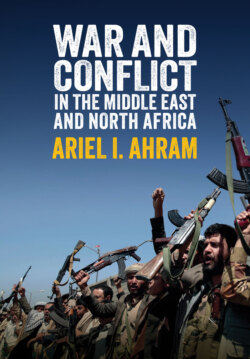War and Conflict in the Middle East and North Africa

Реклама. ООО «ЛитРес», ИНН: 7719571260.
Оглавление
Ariel I. Ahram. War and Conflict in the Middle East and North Africa
CONTENTS
List of Tables
List of Illustrations
Guide
Pages
War and Conflict in the Middle East and North Africa
Abbreviations
Acknowledgments
Introduction
Which MENA?
Why MENA?
How to Read This Book
Notes
1Accounting for War in the Middle East and North Africa
First Cut: Frequency of War
Second Cut: Conflict Types
Third Cut: Conflict Magnitude
Conclusion
Notes
2The MENA Security Predicament
MENA’s Wars and Levels-of-Analysis Problems
Global/Strategic Level
Regional Level
State Level
A Historical Sociology of War and Conflict in MENA
Colonial Wars
Wars of States
“Forever Wars”
Conclusion: A View from Beirut
Notes
PART IICONFLICT TRAPS
Notes
3Oil as Conflict Trap
A Social History of MENA’s Oil Curse
Oil and International Wars
The Oil Price Cycle and MENA’s Regional Conflict
Oil and Internal Wars
Case Study: Oil and War in Libya
Conclusion
Notes
4Identity as Conflict Trap
Group Identities and States in the Middle East
Ethnic Groups and the Equilibrium of Cooperation
Assimilation Strategies
Consociational Strategies
Domination Strategies
Why Ethnic War?
Case Study: Making Ethnic War in Syria
Conclusion
Notes
5Geopolitics as Conflict Trap
Geopolitics as Practice and Discourse
The Geopolitics of Colonialism
Cold War Geopolitics and America’s Ascent
Case Study: Pax Americana, Counterterrorism, and the Greater West Asian Crisis
Conclusion
Notes
6Fragmentation, Integration, and War in the 2010s
Proxy Wars and the Politics of Distant Proximities
From Local Disputes to Civil War
Libya
Syria
Yemen
Networks Unwound
A Thirty Years’ War?
Notes
7Peace and Peacemaking
Defining Peace and Pursuing It
The Evolution of MENA’s Peace Infrastructure
Arab–Israeli Conflicts and the Question of Peace
The Future of Peace, 2011 and Beyond
Conclusion
Notes
Conclusion
Notes
Bibliography
Index. A
B
C
D
E
F
G
H
I
J
K
L
M
N
O
P
Q
R
S
T
U
V
W
Y
Z
POLITY END USER LICENSE AGREEMENT
Отрывок из книги
ARIEL I. AHRAM
Finally, I thank my family for their love and care. My mother, Judi, was a constant source of support. My wife, Marni, and daughters, Matilda and Leonie, all played a role they will never know. I hope, as always, that this book contributes to a good they can inherit.
.....
Chapter 6 offers an extended case study of the last decade of MENA history as a protracted and multi-level regional war. It shows how the civil wars in Libya, Syria, Iraq, and Yemen, often treated as discrete conflicts, became interconnected as theaters in a larger regional and global contest. This contest involved the United States and Russia as the main extra-regional players, but most crucially Iran, Saudi Arabia, Turkey, the UAE, and others as regional actors asserting supremacy. Operating transnationally, the conflict traps escalate war to the point where initial objectives and interests no longer matter.
The seventh and final chapter of the book shifts the focus to peace and peacemaking. There have been innumerable diplomatic plans and efforts to end wars in MENA. Only a fraction have made much impact. Many of these initiatives came from extra-regional powers or their close regional allies. At the same time, “bottom-up” efforts to achieve local conciliation and peace also have a mixed record. This chapter evaluates how different approaches to conflict resolution and mitigation address the potential “traps” of oil, identity, and geopolitics. In many cases, “solving” one trap only exacerbates the problems of the other, creating a Gordian knot that cannot easily be untied. Nevertheless, attention to those places where peace has gained a footing is important for understanding how conflicts in MENA might end.
.....